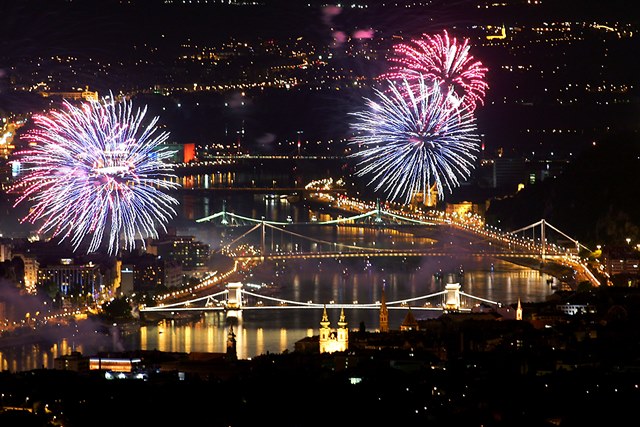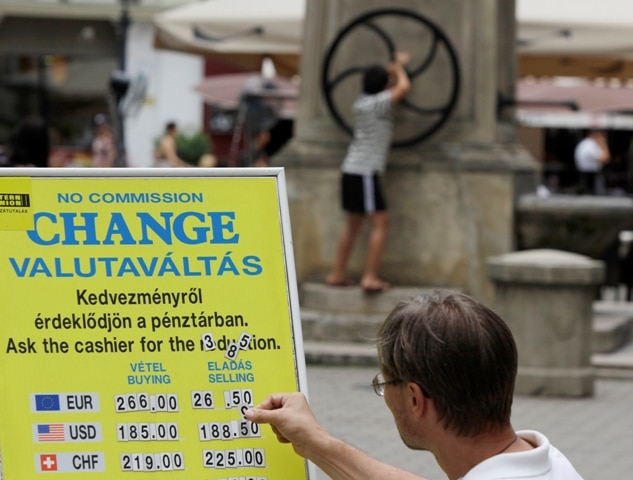Olvasd el angol nyelvű összefoglalónkat augusztus huszadikáról ... hátha ma megkérdezi egy turista, hogy mit is ünnepelünk:) A leckét meg is hallgathatod!
Letölthető tartalmak

If you’re planning to visit the capital of Hungary, the most memorable time for your holiday here would definitely be in August. Every country has at least one date, one national holiday that is significant for its people and spectacular for its visitors. If you happen to be in Budapest on August 20th, you can witness such an event and see how Hungarians celebrate one of their most important public holidays, Constitution Day. However, this day is not only about showing honour and respect to the constitution of the country, but it is also St Stephen’s Day,when Hungarians commemorate their first king. It was King Saint Stephen who laid the foundations and who brought Christianity to the region and to the pagan Magyar tribes, and united them under a strong Hungarian state and Catholicism.
St Stephen himself was born a pagan by the name of Vajk. His father was Grand Prince Géza of Hungary and his mother Sarolt was the daughter of a Transylvanian Hungarian nobleman. When he was baptized a Christian, he was given the name of Stephen (István). If it is true that the meaning of names can predetermine someone’s destiny, this second chosen name surely had some influence on the life of the later King of Hungary. Stephen was not only the name of the original early Christian saint; it also means ‘crown’ and ‘standard, norm’ as well. The later saint King of Hungary dedicated the Holy Crown to the Holy Virgin at his coronation and thus tied the standards of Christian doctrines to his rule, kingdom and future Hungary.
When Vajk alias Stephen reached adolescence, an assembly was called together by his father and they decided he would be his father’s successor as the Hungarians’ next monarch. This was perhaps the first sign that Vajk was going to bring a change in the lives and ways of the Magyar tribes. Until then, according to the tribal customs, the right of succession went to the eldest close relative of the ruler. So not too surprisingly, following the death of Stephen’s father in 997, conflict burst out concerning the rightful succession. Stephen and his uncle Koppány, a pagan chieftain, battled for the status and power of Grand Prince of the Hungarians. The battle was won by Stephen, but it wasn’t solely his own Magyar supporters who helped him to this victory. Stephen had married Giselle of Bavaria, daughter of Henry II The Wrangler just a few years before his father’s death and the German in-laws helped the future king to his pedestal.
His coronation as King of Hungary was in 1000 and his reign lasted for 38 years. During his reign he largely expanded the Hungarian Kingdom and spread Christianity in the Carpathian Basin. In one of his first decrees, for example, he ordered that every ten village had to build a church and he invited foreign priests to Hungary. He also established counties in his kingdom to organize the administration of the country.
He was canonized on the 20th of August 1083, becoming one of the most favoured saints in Hungary.
As a sign of his holiness, St Stephen’s right hand is still intact and it is known as the Holy Right. Today it is displayed as a relic in St Stephen’s Basilica.
On August the 20th you can experience a widespread and varied series of programs in Budapest. The state programs take place in front of the Parliament at Kossuth Square and at Heroes Square. The Hungarian flag is hoisted, marching bands play, there are archery shows, dances, traditional Hungarian crafts workshops, ox and poultry roasted on open fires, etc.
Other festivals take place along and above the Danube. One of the most spectacular ones is the water and air parade. While the fireworks light the summer night skies, various dances tell the story of how Hungary was founded.
DID YOU KNOW THAT…
The Crown of St Stephen was recovered after missing for decades by US soldiers at the end of World War II. It was hidden in an oil drum. It was kept safe at a Ft. Knox vault for 32 years before being returned to Hungary in 1978 by President Jimmy Carter. Today it can be seen in the Hungarian parliament in Budapest.
memorable[ˈmemərəbl̩] – emlékezetes
significant [sɪɡˈnɪfɪkənt] – jelentős
spectacular [spekˈtækjʊlə] – látványos
to witness [tu ˈwɪtnəs] – tanúskodik, bizonyosságot teszt
public holiday [ˈpʌblɪk ˈhɒlədeɪ] – nemzeti ünnep
honour [ˈɒnə] – méltóság
respect [rɪˈspekt] – tisztelet
constitution [ˌkɒnstɪˈtjuːʃn̩] – alkotmány
to commemorate [tu kəˈmeməreɪt] – megemlékezni valamiről
Christianity [ˌkrɪstɪˈænɪti] – kereszténység
pagan [ˈpeɪɡən] – pogány
tribe [traɪb] – törzs
united [juːˈnaɪtɪd] – egyesült
nobleman [ˈnəʊblmən] – nemesember
to be baptized [tu bi bæpˈtaɪzd] – megkeresztelve lenni
to predetermine [tu ˌpriːdɪˈtɜːmɪn] – előre elrendel, meghatároz
destiny [ˈdestɪni] – sors, végzet
influence (on) [ˈɪnflʊəns ɒn] – hatás (valamire)
to be dedicated to [tu bi ˈdedɪkeɪtɪd tuː] – valaminek szentelt
Holy Crown [ˈhəʊli kraʊn] – Szent Korona
thus [ðʌs] – így
doctrine [ˈdɒktrɪn] – doktrina, tan
adolescence [ˌædəˈlesns] – serdülőkor
assembly [əˈsembli] – gyűlés,közgyűlés
successor [səkˈsesə] – jogutód, örökös
tribal custom [ˈtraɪbl̩ ˈkʌstəm] – törzsi szokás
rightful[ˈraɪtfəl] – igazságos, jogos
chieftain [ˈtʃiːftən] – törzsfőnök
to battle for [tu ˈbætl̩ fɔː] – harc valamiért
pedestal [ˈpedɪstl̩] – talapzat
reign [reɪn] – uralom
decree [dɪˈkriː] – dekrétum, rendelet
to be established [tu bi ɪˈstæblɪʃt] – létesít, létrehoz
to be canonized [tu bi ˈkænənaɪzd] – szentté avat
holiness [ˈhəʊlɪnəs] – szentség
intact [ɪnˈtækt] – érintetlen
to be displayed [tu bi dɪˈspleɪd] – kiállítva lenni
relic [ˈrelɪk] – relikvia
widespread [ˈwaɪdspred] – széleskörű
hoisted [ˈhoɪstɪd] – felvont (zászló)
archery [ˈɑːtʃəri] – íjászat
ox/oxen [ɒks ˈɒksn̩] – ökör/ökrök
fireworks [ˈfaɪəwɜːks] – tűzijáték






